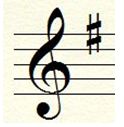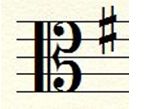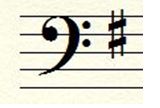Key Signatures represent the notes in the key that are raised or lowered to form the proper scale steps for each scale.

At the beginning of a composition, accidentals are placed on the staff at the same location of the note to be raised or lowered from its natural letter-name, which defines the music’s Key.
For example: In order to form all the correct pitch-steps in a G Major scale, all F’s need to be raised by a half-step, altered to F#.
This sharp adjustment is needed when performing in the Key of G.
The Sharp is written exactly where F’s are located on the staff.




(G Major’s Key Signature is notated above.)
Key Signatures appear at the beginning of the music, directly after the clef symbol and before the time signature.
At times, music changes keys during a piece of music. When changing keys, composers notate Key Signatures directly to the left of the section to be performed in the new key.
As you know, SCROLL enjoys teaching in a detailed and orderly fashion. He has agreed to share his expertise about the Order of Sharps and the Order of Flats, and more Key Signature Codes.





